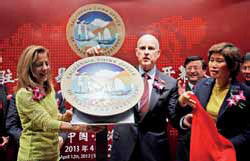California opens Shanghai trade office
Updated: 2013-04-15 10:51
By Yu Ran in Shanghai (China Daily)
|
||||||||
|
California Governor Jerry Brown (center), with his wife Anne Brown (left), unveils the emblem for the California-China Office of Trade and Investment, with Hu Wenjun (right), deputy director of Shanghai Municipal Commission of Commerce, during the official opening ceremony on Friday in Shanghai. AP Photo |
California has reopened a trade office in Shanghai after a 10-year hiatus as the US state tries to attract more investment from China and find opportunities in the world's second-biggest economy.
"We have much to contribute to China, including banking, high-tech, environmental products, and we have much to collaborate on with China in another way, as China is developing rapidly with a great amount of capital available," Governor Jerry Brown said at Friday's official dedication of the California-China Office of Trade and Investment in Shanghai.
Trade between the United States and China increased by more than 300 percent since the latter joined the World Trade Organization in 2001. The countries are each other's second-largest trading partner, with total trade between them exceeding $530 billion worth of goods and services last year.
The new office is a public-private initiative of the state government; the Bay Area Council, a group of business leaders in Northern California; and numerous California companies to promote trade and investment between America's most populous state and China.
"The office will work to connect Chinese investors with the right combination of business concierge services to optimize the client's opportunities in California," said Jim Wunderman, president and CEO of the Bay Area Council.
He said that with China's total foreign direct investment forecast to reach $2 trillion by 2020, a re-established presence in the country will help California capture a substantial chunk.
The state closed its foreign trade offices, including those in China, in 2003.
Brown said Shanghai was chosen as the site for the new office because of the city's position as a financial hub in China. It was also the first sister city for a California municipality in a program between China and the US.
After Friday's dedication ceremony, four deals worth nearly $300 million were signed between Chinese and California companies - in pharmaceuticals, technology, renewable energy, and university-based funding for innovation. On Wednesday, the first day of the governor's weeklong visit, a $1.5 billion China-California investment partnership was announced.
"I want to promote climate-change technologies, renewable energy, building and plants efficiency, low-carbon fuel from California to China with more collaborations in the future," Brown said.
California in the 1970s imposed what are considered the strictest energy-efficiency standards in the US for buildings and appliances. Through those programs and the use of renewable forms of energy such as wind and solar power, the state has saved $50 billion and 23 percent of the electricity that would otherwise have been consumed.
"We are pioneers in energy-saving and renewable energy by making California the only state that has a law that 33 percent of our electricity will come from renewable resources by 2020," Brown said in Shanghai.
He pointed out that California has a goal to have 1 million electric cars on the road by 2025. This is expected to require the participation of Chinese companies in producing more-efficient batteries to increase the cars' popularity.
To introduce California's advanced practices in sustainable urban planning to China, a forum on Saturday addressed the construction of low-carbon-impact cities in China.
"Governor Brown suggested to revive our cities and save resources by promoting mass transit for people to take instead of driving to work, which also will avoid diseases caused by the pollution," Matthew Rodriquez, California's secretary of environmental protection, said at the forum.
"It is time to apply cutting-edge scientific thought about what makes cities successful and to re-examine our cities in light of this most recent understanding, while China has the resources and vision to leapfrog the rest of the world and create the best cities of the future," Peter Calthorpe, principal of Berkeley-based urban-planning firm Calthorpe Associates said in a speech at the forum.
He also said that in Chinese cities, zoning to create transit-focused districts and mixed-use development would benefit pedestrians, bicyclists and public transport users while helping China solve seemingly intractable urban-growth challenges.

 In Photos: 7.0-magnitude quake hits Sichuan
In Photos: 7.0-magnitude quake hits Sichuan
 Li Na on Time cover, makes influential 100 list
Li Na on Time cover, makes influential 100 list
 FBI releases photos of 2 Boston bombings suspects
FBI releases photos of 2 Boston bombings suspects
 World's wackiest hairstyles
World's wackiest hairstyles
 Sandstorms strike Northwest China
Sandstorms strike Northwest China
 Never-seen photos of Madonna on display
Never-seen photos of Madonna on display
 H7N9 outbreak linked to waterfowl migration
H7N9 outbreak linked to waterfowl migration
 Dozens feared dead in Texas plant blast
Dozens feared dead in Texas plant blast
Most Viewed
Editor's Picks

|

|

|

|

|

|
Today's Top News
Live report: 7.0-magnitude quake hits Sichuan, heavy casualties feared
Boston suspect cornered on boat
Cross-talk artist helps to spread the word
'Green' awareness levels drop in Beijing
Palace Museum spruces up
First couple on Time's list of most influential
H7N9 flu transmission studied
Trading channels 'need to broaden'
US Weekly

|

|








